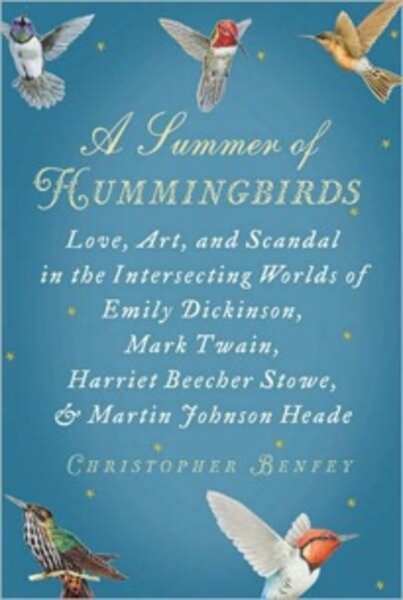At the close of the Civil War, a unique moment in US culture
Loading...
In the summer of 1882, Martin Johnson Heade, an American painter known for his remarkable paintings of hummingbirds, traveled to Amherst, Mass., in amorous pursuit of one of his students – heedless of the fact that she was a married woman. Her name was Mabel Todd and her husband was an astronomer working at Amherst College.
But Heade was destined for disappointment. Todd was already falling in love with another man. Her romantic interest – and, eventually, her lover – was Emily Dickinson’s married brother, Austin. Shortly after Heade’s arrival in Amherst, Todd was invited to play the piano at the Dickinson homestead. To thank Todd, Emily Dickinson sent her a poem – about a hummingbird.
In Christopher Benfey’s A Summer of Hummingbirds: Love, Art, and Scandal in the Intersecting Worlds of Emily Dickinson, Mark Twain, Harriet Beecher Stowe, and Martin Johnson Heade, intellectual and personal plotlines intersect, intertwine, collide, and finish by creating a delicate pattern. It was a relatively small world in the 19th century so perhaps it is not too surprising that the lives of the American intelligentsia of the time were so interconnected. But it is fascinating – and Benfey’s neatly pieced-together book makes for lively and moving reading.
Benfey’s real subject, he tells us, is the “cluster of American artists and writers adrift during the seismic upheaval of the Civil War and its wrenching aftermath.” If you’ve recently read Drew Gilpin Faust’s forceful “This Republic of Suffering,” then the anguish imposed on Americans by the Civil War will be fresh in your mind. Benfey’s more narrow focus on this particular group of “remarkable creative minds, who survived the war and the loss of so many certainties” serves as an interesting amplification of Faust’s thesis that the war altered Americans irrevocably.
Benfey teaches English at Mount Holyoke College. The hummingbird leitmotif, he explains, occurred to him when he discovered that so many of the period figures who interested him – Mabel Todd, Martin Johnson Heade, Emily Dickinson, Thomas Wentworth Higginson, Henry Ward Beecher, and Harriet Beecher Stowe – were all “fanatical about hummingbirds.” (The hummingbird was also a key figure in the debate over evolution started by Darwin’s 1859 “The Origin of Species.”)
Perhaps the hummingbird, with its tiny size, remarkable speed, and evanescence, seemed an antidote to the suffering of the war. Or perhaps these lively talents – many of whom flitted from passion to passion and not always wisely – saw something of themselves in the little bird. The many overlapping love affairs Benfey recounts seemed to bring more difficulty than succor. The various voyages made in search of peace or beauty (Heade to Brazil, Harriet Beecher Stowe to Florida, many of the period’s celebrities to the Hotel Byron in Switzerland) did not always deliver.
Of course the emotional toll of the war was enormous. Harriet Beecher Stowe’s son Fred survived the war but was destroyed by it. He hoped a long sea voyage might restore him but, instead, in 1871 he “stepped off the ship and vanished into thin air. He was never heard from again.” His mother never got over the loss.
Even in her seclusion in Amherst, Emily Dickinson felt the war intensely. In 1861, she wrote that she would “have no winter this year – on account of the soldiers.” Instead, she said, “when the Humming birds come down” she would shut her eyes “and go far away.”
But for this cluster of thinkers, there is no escape from one another. Mark Twain, who visited Nicaragua a few months after Heade’s trip there, bought one of Heade’s Florida landscapes for his Hartford home. Henry Ward Beecher, whose infidelities nearly undid him, was a collector of both hummingbirds and Heade’s paintings. Austin Dickinson and Mabel Todd blasted their own lives with their affair but in the end, it was Todd’s connection with their family that saved Emily Dickinson’s work from obscurity. “Almost alone among her contemporaries,” writes Benfey, (and beginning with Dickinson’s hummingbird poem), “Mabel Todd recognized the genius of Emily Dickinson’s poems and shepherded them to a wider public.”
Benfey closes his examination of these eventful 19th-century lives with a thrust into the future. In the 1940s and ’50s, American artist Joseph Cornell became fascinated with both Heade and Dickinson and introduced the hummingbird into his own work. And so in a move that seems almost a feat of time travel, the little bird darted once again into another century of American culture.
Marjorie Kehe is the Monitor’s book editor.






